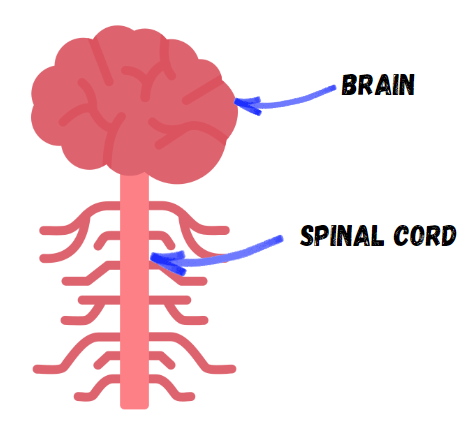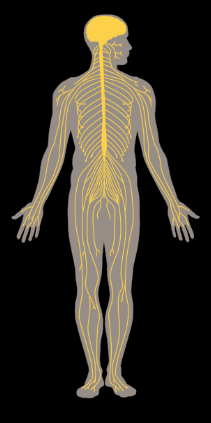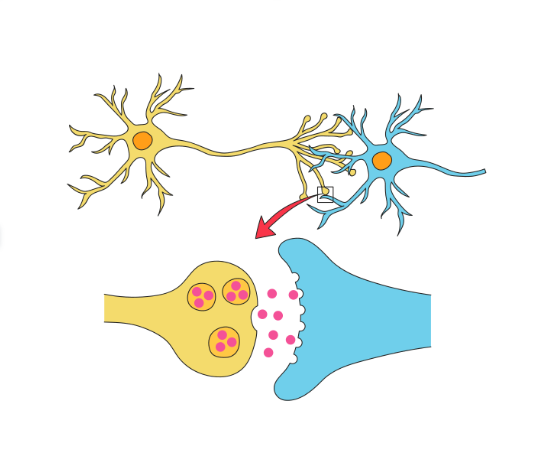The nervous system is the command center or control of our body, and it help us to receive information from around us, process them,and send a response. It works as a sophisticated multiple communication system which helps us in receiving sensations from the world, make decisions and control our movements. This blog will dive deep into the nervous system describing its different parts and functions.
Central Nervous System
The central nervous system (CNS) is the main part of our body’s control center-it consists only of your brain and spinal cord. The brain, which is contained in the skull and serves as an all-in-one main processor for sensory information interpretation (perception), regulating of muscle movement. emotions behavior modification & allowing thoughts to run around inside us. Running down the back from the brain, a communication highway called spinal cord carries messages between your body and mind.

Peripheral Nervous System (PNS)

The peripheral nervous system (PNS) is a vast network of nerves that extends throughout the body, connecting the CNS to the organs, muscles, and skin. It acts as the communication bridge, relaying sensory information from the body to the CNS and transmitting motor commands from the CNS to the body’s periphery. The PNS is further divided into the somatic and autonomic nervous systems, each with distinct functions.
Somatic Nervous System
The somatic nervous system is responsible for controlling voluntary movements. It consists of nerves that connect the CNS to skeletal muscles, enabling conscious control of muscle contractions. When you decide to raise your arm or take a step, the somatic nervous system transmits signals from the brain to the appropriate muscles, initiating the desired movement.
Autonomic Nervous System:
The autonomic nervous system (ANS) governs involuntary bodily functions, operating without conscious control. It regulates vital processes like heart rate, breathing, digestion, and temperature regulation. The ANS is further divided into the sympathetic and parasympathetic nervous systems, which often work in opposition to maintain homeostasis.
Sympathetic Nervous System
The sympathetic nervous system is the “fight-or-flight” response, preparing the body for stressful situations. It increases heart rate, dilates pupils, and diverts blood flow to muscles, enabling quick action in emergencies.
Parasympathetic Nervous System
The parasympathetic nervous system is the “rest-and-digest” response, promoting relaxation and conserving energy. It slows heart rate, constricts pupils, and stimulates digestion, facilitating recovery after stressful events.
Sensory Receptors
Sensory receptors are specialized cells that detect stimuli from the environment and convert them into electrical signals that the nervous system can interpret. These receptors are located throughout the body, enabling us to experience the world through touch, sight, smell, taste, and hearing. Sensory information is then transmitted to the CNS for processing and interpretation.

- Mechanoreceptors
- Chemoreceptors
- Photoreceptors
- Thermoreceptors
- Nociceptors
Neurotransmitters
Neurotransmitters are chemical messengers that transmit signals across synapses, the junctions between nerve cells. They play a crucial role in communication within the nervous system, enabling information flow between neurons. Different neurotransmitters have distinct effects, influencing mood, sleep, appetite, and various other physiological processes.

| Neurotransmitter | Function |
|---|---|
| Glutamate | Excitatory, learning, memory |
| Acetylcholine | Muscle contraction, memory, learning |
| Dopamine | Reward, motivation, movement |
| Serotonin | Mood, sleep, appetite |
| Norepinephrine | Stress response, alertness |
| GABA | Inhibition, anxiety reduction |
Nervous System Disorders
Nervous system disorders encompass a wide range of conditions that affect the brain, spinal cord, and nerves, impacting various aspects of physical and mental well-being. These disorders can arise from genetic factors, environmental influences, infections, or trauma. Some common nervous system disorders include:
- Alzheimer’s disease
- Parkinson’s disease
- Multiple sclerosis
- Stroke
- Epilepsy
- Cerebral palsy
- Spinal cord injuries


Great 👍
Thank you
A great read!!😍
Thank you ✨
Great one 🖤 keep it up 💕
Thank you ✨
add your blog https://sithuvili.net/
Thank you.I will definitely do that
Family Dollar Very well presented. Every quote was awesome and thanks for sharing the content. Keep sharing and keep motivating others.
Thank you ! Stay connected with us
Aroma Sensei I really like reading through a post that can make men and women think. Also, thank you for allowing me to comment!
Thank you ! Stay connected with us
Mountsinai Very well presented. Every quote was awesome and thanks for sharing the content. Keep sharing and keep motivating others.
Thank you ! Stay connected with us
Noodlemagazine I very delighted to find this internet site on bing, just what I was searching for as well saved to fav
Thank you ! Stay connected with us
Noodlemagazine You’re so awesome! I don’t believe I have read a single thing like that before. So great to find someone with some original thoughts on this topic. Really.. thank you for starting this up. This website is something that is needed on the internet, someone with a little originality!
Thanks a lot! You truly inspire me to keep writing more blog posts.
Mat6tube Awesome post! We’ll be linking this exceptional article on our platform. Keep delivering great content
Thanks a lot! You truly inspire me to keep writing more blog posts.
FlixHQ I enjoy the practical information you provide in your content